For decades, immersed in studying, working, learning, and teaching in the craft of meat curing, now sharing his passion with you through eat cured meat online resource.
Here is a quick guide about the pellicle and why it helps when smoking meat. I’ve been meat smoking for decades and have always been looking for helpful traditional & new techniques. I love smoking all kinds of meat, including store-bought, farmed & wild meat.
KEY POINT
Before smoking meat, the pellicle drying process is performed. Depending on the conditions, it will take 20 minutes to 8 hours. The two key factors are a cool area and airflow.
This is a mistake I’ve seen many times with online content about smoking meat; for hot smoking, it’s essential. Low and Slow Smoking dries the meat during the process and is irrelevant.
Top Tips
- As a rough guide, keeping the temperature under 65°F/15°C when forming a pellicle, a bit hotter is OK from my experience (Commercial fish smokers work in much higher temps).
- The salt in the meat will preserve it a little, so it won’t spoil if left out in coolish temps, like a non-refrigerated shed/basement with a fan
- If you leave it too long in the fridge (multiple days), it may become leathery, and flavor compounds won’t stick. (I’ve been there.) As with anything, keep an eye on it, touch it, and feel it!
- Cover the meat if it’s in the open with muslin so bugs can’t get to it when forming a pellicle
- When forming the pellicle, don’t sit it on a flat bottom pan; make sure there is a rack (wooden skewers work on a concave dish) or it’s hung so it has surrounding airflow
- Previously frozen fish will produce very little pellicle; from my experiences
Cold smoking helps a lot from my experience.
I have learned how vital a pellicle is for smoked meat. This straightforward guide will explain why and how and put you on the right track.
How to Form a Pellicle on Smoked Meat?
Once complete, the meat will have a dry, sticky layer. A pellicle allows smoke to flavor the meat.
It’s all about sealing in moisture and flavor, and if this is done right, you will be feasting on delicious smoky delights. There are many different types of meat to smoke; this straightforward guide below will cover all the basics of the pellicle:
Different Types of Meat, Pellicle Formation Time
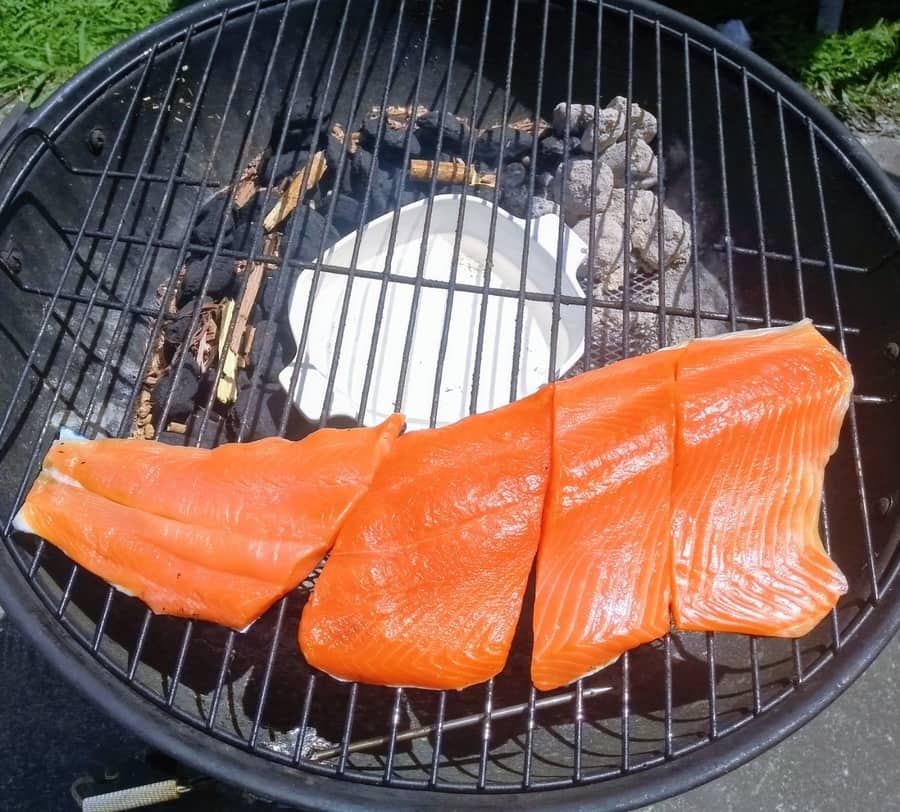
If you think in terms of how dense the meat is, then this will give you a rule of thumb about,
How long To Form a Pellicle for Smoking Meat:
| Meat | Minimum Time | Ideal Time |
| Pancetta/Bacon Pork Belly | 1-4 hours | Overnight |
| Trout / Salmon Fillet | 30-60 mins | 1-4 hours |
| Chicken/Turkey Breast | 2-4 hours | 3-6 hours |
| Seafood | 30-60 mins | 2-4 hours |
| Seafood – mussels/scallops | 30-60 mins | 1-3 hours |
| Whole Fish (under 6lb/3kg) | 2-4 hours | Overnight |
Note, whole fish style hot and cold smoking is another topic in itself.
Air Flow & Cool Area = Pellicle
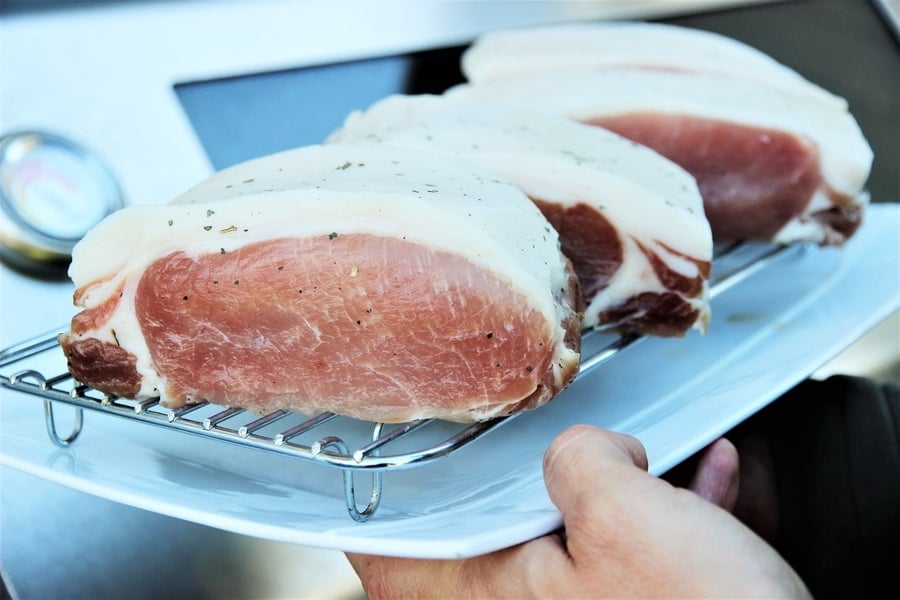
The smoke flavor phenol will attach to the fat more; again, there is something to watch out for.
If there is too much fat, the flavors will not be able to diffuse. Trimming down fatty chunks of beef or pork can be a good idea. Like any cooking, use your senses. Poke it and see if it sticks a little to your finger when you touch it.
Common sense will help guide you. I have found that fish fillets can quickly form a pellicle in the fridge.
The wood’s flavor compounds won’t stick until the protein is dry enough to form a tacky pellicle. Maybe your fridge has excellent airflow (maybe not), or maybe it’s winter, and you can use a shed or cellar area—there are lots of options.
You can also point a fan onto the meat in a cool environment.
These factors will all vary over time, so all you need to do is use some common sense and observe.
The smoke flavor phenols will attach to the fat, again there is something to watch out for. If there is too much fat, the flavors will not be able to diffuse.
Trimming down fatty chunks of beef/pork can be a good idea.
The color and flavor of smoked meat vary depending on the gases, it’s not specifically about the visual smoke. That’s why you hear the term ‘thin’ blue smoke because the wood combusts efficiently and just a transparent blue smoke can be seen (or other colors, I get yellow thin smoke too).
Lots of friends, myself included, when I started, didn’t have enough airflow or over smoked. Less is better for either indirect or direct smoking (portable smokers).
Thin smoke from my portable smoker:
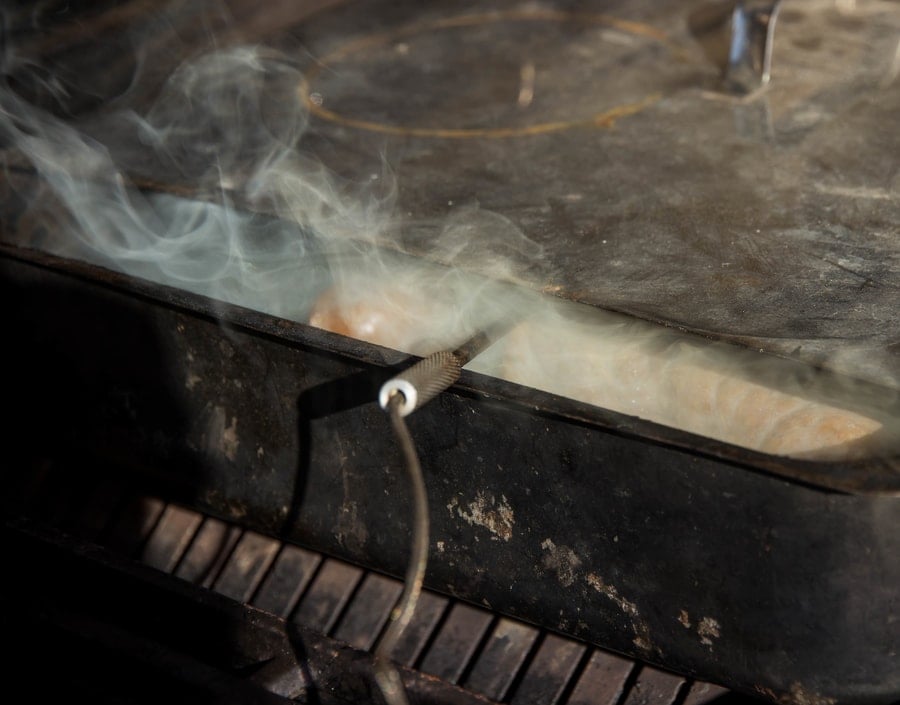
They say the resins combine with the sugars, starches,
This hot-smoked fish was only in the smoker for 15 minutes. It had a well-formed pellicle, and you can see the color it took on from the wood.
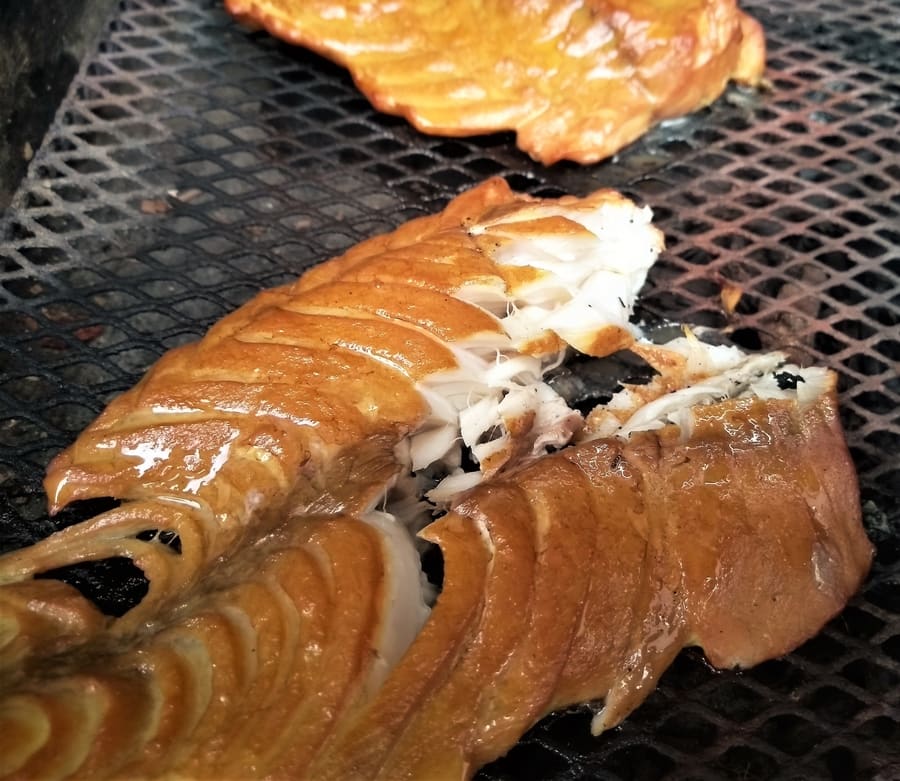
The color and flavor of smoked meat vary depending on the gases; it’s not specifically about the visual smoke. They say the resins join with the sugars, starches,
Advantages of a Pellicle
- More smoky flavor
- Antibacterial skin to protect
- Seals in moisture
- Foreign bodies, like soot, don’t stick to the meat when smoking as much
- The better overall smoky color
What Does A Pellicle Look Like?
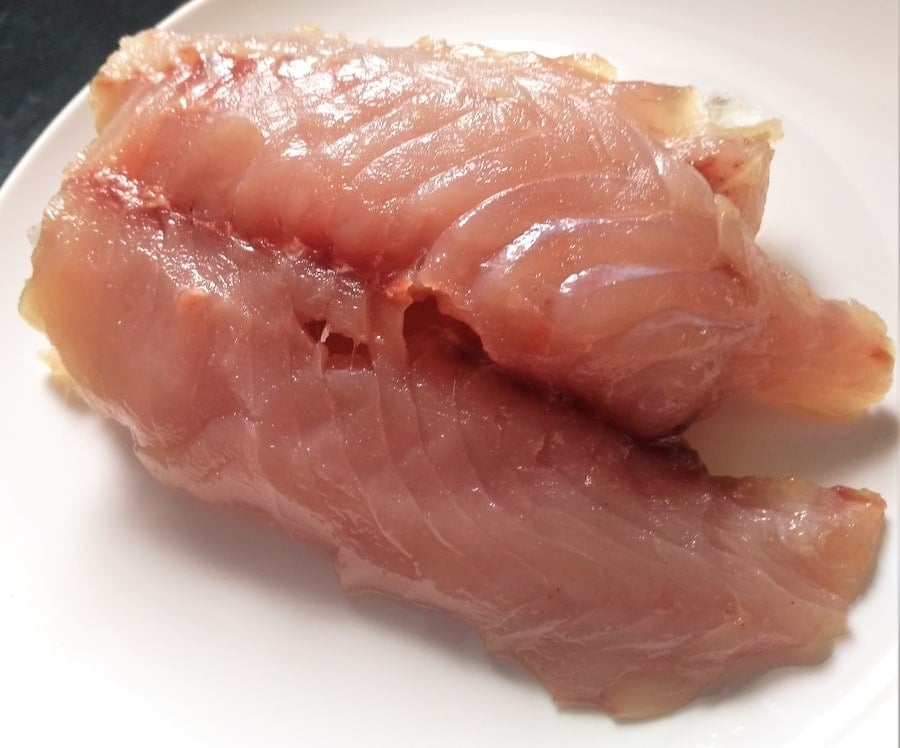
Does Smoking Meat Prevent the Formation of the Pellicle?
No, BBQ bark & pellicle is the proof of this. However, the smoking time is over a long period, generally over 6 hours.
Furthermore, low and slow bark is a combination of spices, sugar, and salt. It is rubbed over the meat before smoking. It’s a sugar crust that hardens on the outside of the meat, which occurs over the long Low and slow smoking session over several hours.
Because Southern-style BBQ is such a big topic, I will have to elaborate on it in a separate post.
But in short:
A smoker is generally in a dry environment. When Low and slow smoking for a longer time (6 hours to multiple days), a pellicle can/will form in the smoker under the rub. But if the pellicle forms too much, it will harden (polymerizing into a hard skin, so it
It is interesting that a pure wood fire provides some moisture trapped in the wood. This applies to offset smokers or traditional smokehouse cold smoking, where the smoke is vented in through a tunnel.
Or a smoke generator like Smokai (review I did; great product).
It’s a balancing act; some like to use water pans to keep the humidity higher inside the smoker.
Hence, BBQ enthusiasts have a spray bottle of liquid, often apple juice – to stop them from drying the meat out (note, this takes practice!). The Low & Slow Southern Style! (Generally, due to the sweet, sugary rub, it’s a very sweet outcome, but everyone loves it).
So, the pellicle will form, and the smoke will adhere to it.
Of course, thin blue smoke is best (I mention the quality of smoke at the bottom of this post).
Purpose of Pellicle
From what I have been reading, the pellicle is a thin layer of tissue; it comprises protein and some other components.
It’s to protect the meat in a way.
Because you can smoke any meat, hard cheese, vegetable, seafood, sausage or nut.
The pellicle is a meat item that will help create that smoky flavor. The woods and the food you can use are endless, but we seem to focus on meat for some reason.
Smoking has some preserving properties in the form of phenols; this limits the formation of bacteria that make meat inedible.
Some don’t think it matters, and in specific scenarios—say, BBQ Southern style—it doesn’t because of long smoke times. I think the pellicle will develop during the smoking process. This is just a glimpse of the entire diverse world of smoking food.
List of Different Ways to Create a Pellicle
- Put it in the oven, or turn on a
fan , to create the airflow (no heat) - In the fridge on a rack/hanging or bamboo skewers (airflow!)
- In a cool breezy shed or garage (ideally protected by muslin)
- If the temperature is under 60°F/15°C and you have airflow in the smoker. Then you can use the smoker before the heat is turned on
- In a smoking box/fridge/house with airflow
Are you interested in meat curing (here’s something about the equipment) to make dry-cured meat like pancetta, lonza, or braesola? Here is a post I wrote on all of that.
Tip: If it’s open, you might need to wrap it in muslin to keep bugs off.
For instance, I have left fish fillets hanging in a small shed for 6 hours. Not in direct sun, to keep it cool – worked a treat.
Smoking Salmon – Forming a Pellicle
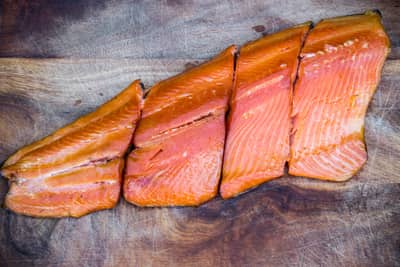
The color and texture you can have from smoking salmon (here are methods I wrote about )are sublime.
When you do it at home – it just doesn’t compare to anything bought, unless it’s a true artisan or done with a passion I find.
My personal preference is overnight using a dry cure in the fridge. I’m looking for balance once the pellicle is formed. I will use lighter wood flavors to compliment the salmon, like applewood (here is a guide to smoking wood).
The tacky glow of a well-formed pellicle on salmon can be seen; it looks like jelly.
The pellicle forming is a choice, and it becomes more effective on shorter smoking runs like hot smoking.
In longer forms of meat smoking, the dry nature of the smoking area means the pellicle can form during the process (i.e. 1-7 days). All in all, if you want smoky flavor – this step is important.
A Shorter time is needed since salmon isn’t dense. And of course, it comes down to how smoky you want it, I like balance and look to complement the fish.
Also, whether you are hot or cold, smoking the salmon is important.
If you want more info on how I smoke salmon, both hot and cold smoking, please find a post I wrote here.
Most folks will be hot smoking, so forming the pellicle is more important since the salmon will only be in the smoker for a short time.
So the same applies to smoking cheese, garlic, or tofu
My brother is a keen trout smoker, and his preference is straight in a hot smoker – he wanted to taste a fine trout in excellent condition.
How Long to Form Pellicle on Bacon?
Overnight in the fridge with airflow around the meat is ideal to form the pellicle. The bacon can form the pellicle within 4 hours depending on temperature and airflow. For hot smoked bacon, pellicle formation is very important.
Bacon – Hot or Cold Smoking
Again it comes down to hot or cold smoking bacon, my advice is the same – if you are hot smoking. You will get the benefits from forming the pellicle overnight.
Cold-smoking bacon will take 1 to 7 days so that the cold smoker (here are other DIY cold smoker ideas I put together) will dry the bacon during the process.
If we are talking Italian pancetta, lighter smoking would be the way to go. Let’s not get into the differences between Pancetta and bacon here.
For triple-cold smoked bacon, automation is key (20 hours+). To have the setup for this generally means some kind of automatic or thermostat-controlled smoker-set-and-forget setups are ideal. You can read more of this post. Wireless or inbuilt thermometers are a blessing also, as they mean you don’t micromanage what’s going on.
I’ve seen traditional Dutch butchers with piles of darker-flavored wood chips on the ground. They just let it smolder for days. It doesn’t have to be complicated with cured meat, but this gentleman had 40 years of experience with Dutch-style smoked goods, respect.
If you want to read a summary blog on meat curing at home, I wrote a decent-sized post here.
Can I Form a Pellicle at Room Temperature?
You can form a pellicle if the room temperature is cool and below 68°F/20°C. For fish or less dense meat, it will form faster in approximately 30 minutes to one hour. Using a fan to create air circulation can speed up the time it takes.


Comments
I am experimenting with smoking mackerel in the tropics (I lie in Bali).
We can cure it in local sea salt and coconut palm sugar and smoke over coffee wood, which is how we smoke bacon here. I am concerned about the pellicle step though because the ambient temperature is so high, I am afraid the fish will go off if at room temp for any length of time. The fridge has no fan. Could we use an air conditioned room with a fan?
Heya, I guess that would be the gamefish type mackeral instead of the cold water oily variety around the UK.
You probably know fish deteriorates pretty fast when it isn’t on ice or at fridge temp. Fridge temperature would be way better. I’m presuming you cooking/smoking it.
It can take just 1-2 hours to get a pellicle going, especially with airflow. So maybe try a small piece, not a whole fillet, I know they are big!
To CatWheeler,
All fridges have fans 😊. You just cannot see them. That is how the cold air gets from the cold coils of the device into the fridge and freezer. Do not worry. You can do this in your fridge, no problem. Follow Tom’s advice and allow airflow all around the meat: elevate on a rack or skewers or tie it with butcher’s twine and hang it!
Happy Smoking!
Gina
Hey thanks, I’ve had old domestic fridges that have the coolant ‘bar’ at the back – I dont believe these actually had a fan to circulate, for more modern fridge, I have! (because I’ve converted x6 fridges for DIY drying chambers, I’ve done some research!). Kindest regards, Tom
I have smoked coral trout here in the tropics in fnq Australia. I used a wet brine of water,salt,brown sugar,soy sauce,chilli etc,in the fridge over night. Fillet your fish, leave skin on. When ready to smoke pat it dry with towel, do not wipe it. Then hot smoke for around 15 minutes
Cool mate, nice one my mum is retired to Cairns, I’ve lived that part of the world for 6 years prior. Had an epic 4wd adventure to Bamaga!
Mud crabs are my no. 1 favorite meat!
Pingback: How to Make the Best Bacon – (Calculator & Guide) | Eat Cured Meat
I live in Sydney. We have been hot smoking kangaroo tails. We pull the skins off and soak them in an aboriginal tree root brine with garlic bay leaves and sugar from the Kakadu plum overnight and then wag them in the sun for six hours to get a pellicle. Then we smoke them on the Recteq 5 hours while we put away heaps of Fosters oil cans. The kids bloody love ‘em.
Nice! Love to hear local ingredients being used! I am heading to see mum in Cairns next month, might track done some tree root brine! 🙂 Cheers Tom